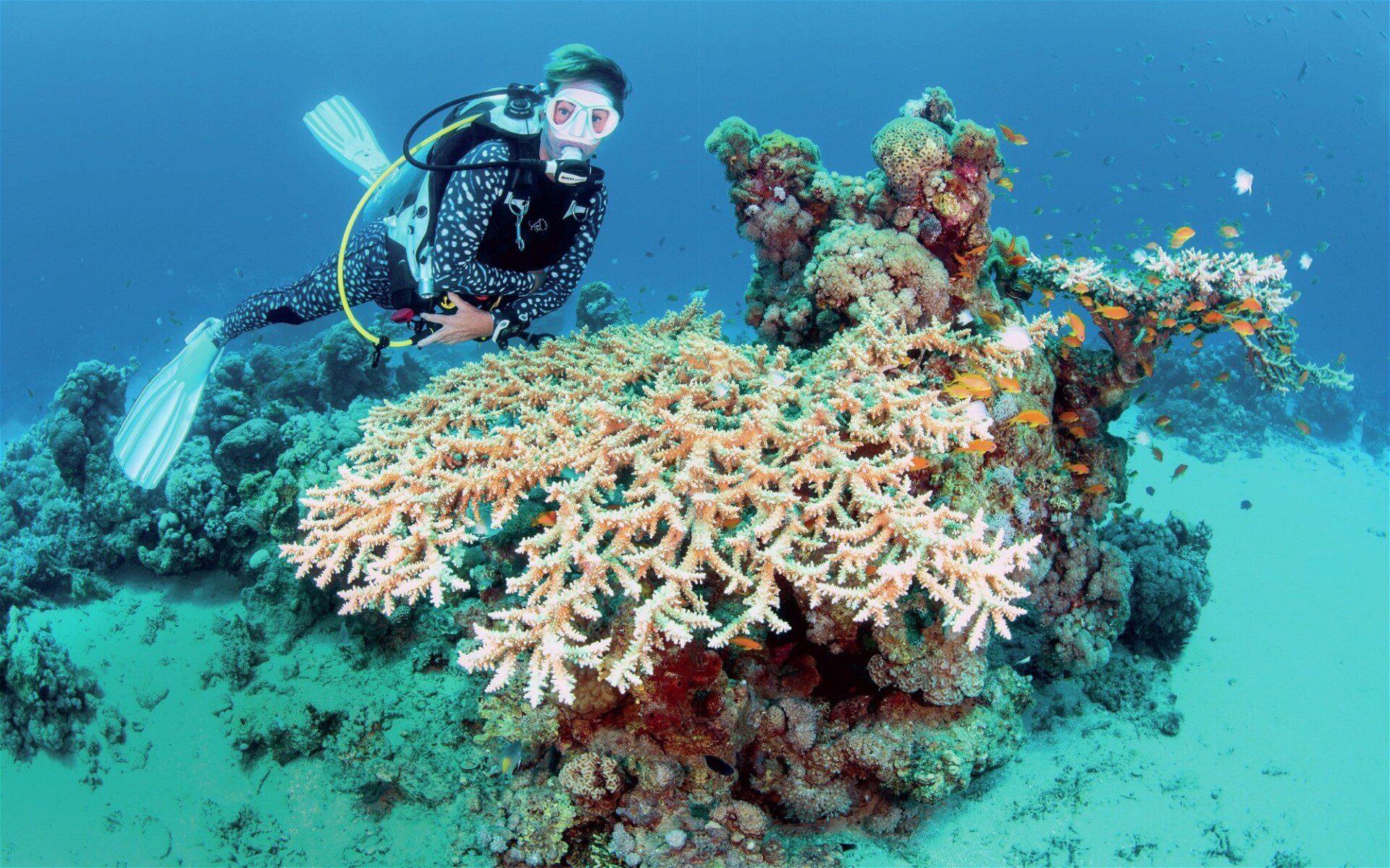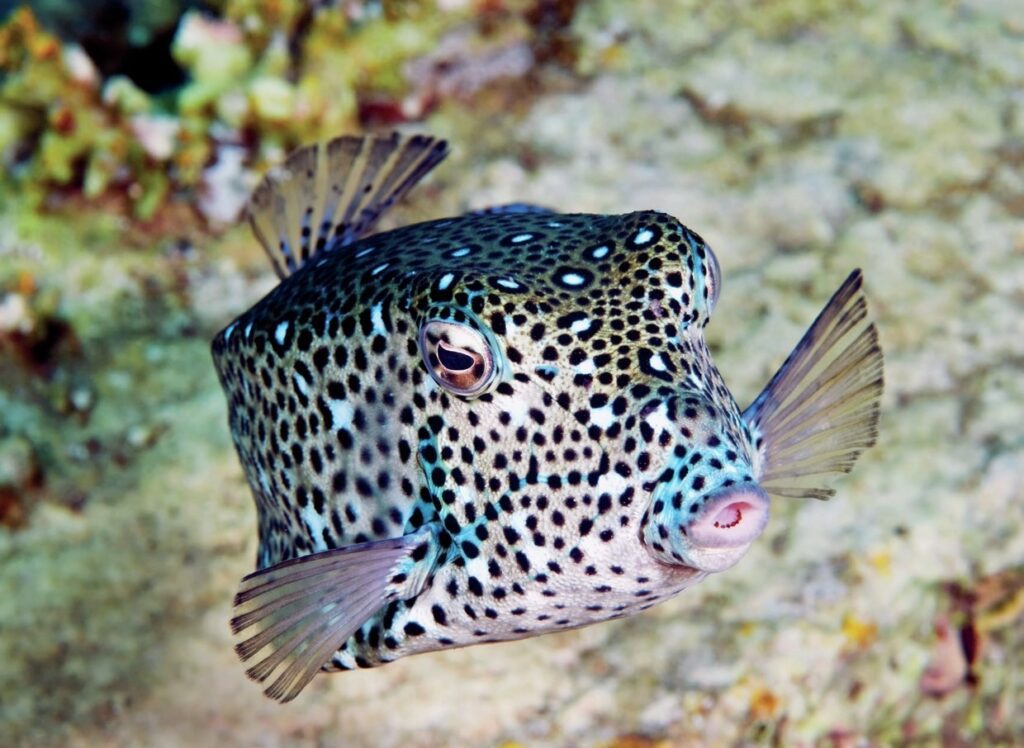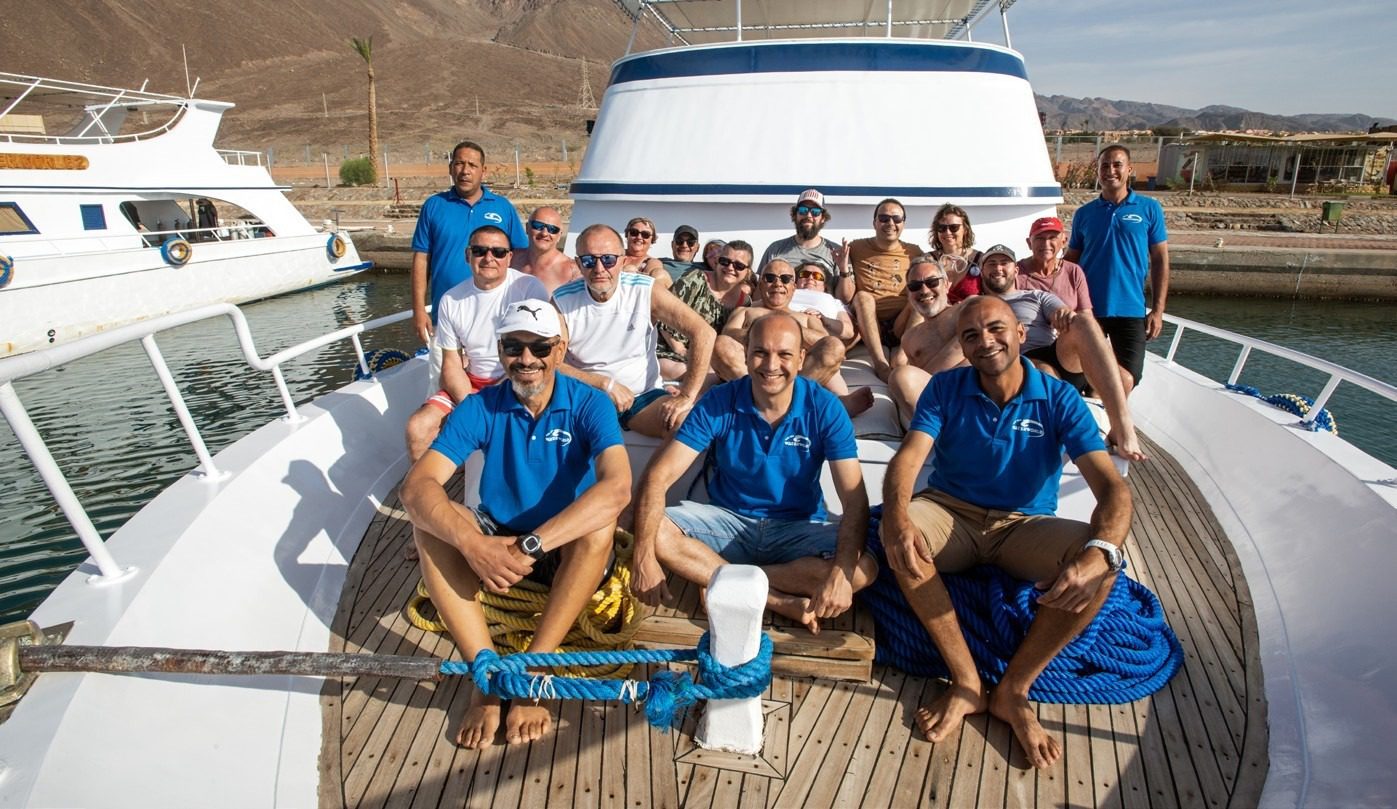The resort of Taba Heights was always a popular destination for divers, especially underwater photographers, and it was a shame to see it fall off the grid after the devastating floods of 2014. Now it is making a return to the diving scene, and Stuart Philpott flew out to check it out firsthand.
Photographs by Stuart Philpott
Giant frogfish have always been the superstars of Taba Heights in Egypt. During its hey-day, froggie sightings were virtually guaranteed at every dive site. Masters of stealth and camouflage, they are notoriously difficult to find and tricky to photograph.
Fortunately, frogfish don’t move around much and often stay in the same area for weeks. Once located, the dive guides can usually return to the same spot time and time again.
Moving forward to present day and Taba’s dive sites hadn’t been explored for almost a decade, so finding a frogfish wouldn’t be as easy. I was joined by a group of French divers from Paris. Weather conditions looked ideal.

Sea temp was still a little chilly this early in the season, but I managed to survive in a 5mm shortie. We spent the entire week searching for froggies and not a single sighting.
Feeling slightly deflated, I washed and packed my dive kit away in preparation for the flight back home. A ping from my mobile broke the silence. Tamer, the GM at Waterworld Diving and Watersports Centre, sent me a message saying the French group had spotted a bright green froggie on their very last dive.
In a mad panic, I reassembled my camera and hot footed it to the dive centre. Tamer organised a dive boat and my model for the week, Stella Sobol, after some swearing and cursing, got ready for action. But as we left the jetty, I realised my shorts and rash vest had been sent to the wrong boat, which left me with an interesting dilemma.

Dive in my underpants, or go commando? Would this scare away Stella, or even worse, the elusive frogfish?
Taba Heights used to be an extremely popular holiday destination attracting a massive following from the UK, including many repeaters.

Did you know?
Taba Heights is an all-year-round destination, with moderate weather and sunshine throughout all of the seasons.
The main complex consisted of five hotels with a PGAstandard 18-hole golf course in the centre. The whole infrastructure worked well, with blue tuk-tuk buses regularly transporting guests to and from the hotels, Waterworld and the downtown shopping/dining area.
From 2004 to 2010, I owned and managed the little photo centre at Waterworld. This was an extremely busy time. Every day, the dive boats ferried divers to and from the local sites, 20 or more Discover Scuba divers went to Marina Bay, and the Henry de Monfreid was full up with snorkellers and partygoers.
Other activities included parasailing, wakeboarding, sailing, quad biking, camel rides, jeep safaris, stargazing trips to the desert and much more! My staff used to take pictures of all the happy customers.

I specifically dealt with the divers and having logged four dives a day for six years, I can honestly say I knew the sites fairly well. I even created the underwater maps for each site, and wrote a dive guide called Taba’s Treasures!
A culmination of events resulted in the resort’s dramatic decline. Directs flights from the UK to Taba airport were virtually withdrawn overnight, and then in May 2014, a massive flood devastated the hotels and the golf course.
A raging torrent washed down from the mountains through the resort and into the sea, taking a huge amount of silt and debris with it. This obviously affected the dive sites, many of which are located directly in front of the hotels.

Slowly, slowly the resort has been rebuilt and is now coming back to life. The Intercontinental (now called the Strand) managed to stay open continuously. Last year, the Sofitel (now called the Mosaique) re-opened and the Marriot (now called the Bayview) opened in April this year.
The beachside walkway connecting the hotels has also been replaced with new tiles. There was talk that the Three Corners El Wakala, located in the downtown area, would be next. Pub Tandoori used to be the best place for a curry and watching international football matches on the giant TV screens. I was pleased to see this was back in business with an authentic Indian chef.

Hotel guests can visit the restaurant as part of the ’dine around’ policy. Sadly, the Hyatt will need a substantial amount of repair work. The beautiful lush gardens have died and lagoon run dry. It was quite distressing to see this once-thriving hotel in such a poor state.
Over the past few years, Taba Heights has mainly been catering for Israeli, American and Eastern European clientele. But hopefully there will be regular flights running from Paris to Taba Airport very soon. Currently the best option from the UK is a direct flight to Sharm followed by a two-hour coach or taxi transfer.
For the past decade, Waterworld has been mainly ticking over with snorkelling trips to Farun Island, a few Discover Scubas, and banana and parasailing rides. I couldn’t believe that after all this time, most of the same staff were still working at the centre. It was good to see so many familiar faces.

The majority of dive sites have not been visited since the flood in 2014. No one had any idea what to expect. For all I knew, they could have been destroyed beyond repair. I kept in touch with the owner Alain Sobol, constantly badgering him for updates. In May this year, a group of French divers booked a trip to Taba Heights and I managed to join them.
There are probably 11 main dive sites to explore. Shab Ghamila (aka Radisson Reef) and Muqabila lie to the south of Waterworld. Heading north is Zak’s Tables, Angels Net, Aquarium and Ras Amira located a few hundred metres in front of the hotels, leaving Maxwell’s, Fjord and the furthest site, Farun Island. Waterworld’s house reef and neighbouring Marina Bay just about completed the tally.
On the way out to Ras Amira, our first dive site, we saw dolphins and turtles, which was a nice surprise. Ras Amira was always a good choice for training and check-out dives. The sandy seabed is covered in small coral pinnacles.
I remembered the mooring line pinnacle used to have an anemone with two resident anemonefish and to my surprise they were still there! Whether it was son of anemonefish or the same ones I have no idea, but they were quite relaxed and allowed Stella to get close for a picture. I had a good look around the site and it hadn’t changed at all in ten years.
Maxwell’s was always an extremely active site full of coral pinnacles with dense shoals of bright orange anthias. It never failed to impress. I’m pleased to say the site was also in great condition.
We went from pinnacle to pinnacle encountering octopus, grouper, lionfish, crocodilefish and puffers, but strangely no moray or frogfish.
Waterworld’s House Reef was probably the most-affected dive site of them all. There used to be a guide rope leading out to eight little artificial reefs all in a row at around 6m-8m. The piles of concrete blocks were added in 2001 when the centre opened.
They were colonised with moray, lionfish, scorpionfish, stonefish, puffers, boxfish as well as octopus and seahorses. A layer of fine silt now covers everything. There was no sign of the rope or the blocks. I found a few lionfish and moray eels, but nothing significant.
Tamer told me to go down the mooring line and the sink hole at Fjord would lie directly in front. The almost perfectly round 30-metre diameter hole begins at a depth of 12m and bottoms out at 30m, where there are a number of boulders and a small overhang.
I couldn’t find the red anemone plus anemonefish that used to live on the wall at 15m, but I did find the glassfish pinnacle. Once upon a time there used to be a bright green frogfish sitting close by, but I could only find a few lionfish and a scorpionfish.
The French group took a shine to Muqabila and ended up going back there twice. Having mainly trained in lakes, they liked the steep drop-offs and the open seascape. The huge dome corals were instantly recognisable. Tamer said he had seen an eagle ray several times. We found a pufferfish and a number of lionfish, but nothing as exotic as an eagle ray.

One of my favourite sites used to be Sha’ab Ghamila. The pinnacles used to be thriving with morays, anemonefish, ghost pipefish, lionfish, puffers and many many more species, including turtles, barracuda and even a dugong. I have seen more frogfish at Sha’ab Ghamila than anywhere else.
Tamer said the site had been totally destroyed and there was no point in checking it out, but I wanted to be thorough, so persisted. Eventually we got to dive at the site and yes, the underwater topography has changed dramatically.
The two main pinnacles have collapsed and the discarded fish traps lying in the seagrass beds were gone along with all the sea grass. I could always rely on the fish traps for a frogfish or two. The corals didn’t look as vibrant, but fortunately the marine life had multiplied! This is still the best site for macro photography. We spent an hour exploring the pinnacles and I could have stayed even longer.

The furthest dive sites are at Farun Island, which is about 45 minutes boat ride away. The old castle fortification dates back to the 12th century and is linked to the Knights of the Crusade.
This makes a great backdrop for pictures and adds a historical flavour to the dives – who knows there could well be a hoard of ancient treasure still buried somewhere along the sea wall. This was always a very popular site, so I wasn’t surprised to see two dive boats already moored up when we arrived.
Away from the island across the channel on a compass bearing of 240 degrees there are two small glassfish pinnacles that used to attract frogfish. Stella and I crossed the main channel full of seagrass and startled a green turtle.
Unfortunately, it didn’t stay around for a picture. The pinnacles didn’t look as vibrant as I remember. There wasn’t so many glassfish and no sign of any froggies.
We followed the wall around towards the open sea on our second dive. There can be some current but it’s usually minimal. In the shallows there are many pinnacles covered in fire coral with anemones and anemonefish, damselfish, angelfish and anthias.
Crocodilefish and octopus are also sighted here. At the edge of the wall, we spotted two nicesized Napoleon wrasse, but they wouldn’t come very close. The wall bottoms out at around 30m, where there is an old fish trap or two lying in the seagrass.
The dive sites in front of the hotels were my main concern. What had happened to Aquarium, Angels Net and Zak’s Tables after the flood? I was always impressed by the huge four-metre diameter table corals at Zak’s Tables.
We descended onto a large pinnacle surrounded by giant table corals. The pinnacle was full of grouper, damsels, lionfish, anthias and anemonefish. There was slightly less marine life on the table corals but otherwise nothing had changed. I once had a giant froggie sitting on my shoulder, but again there were no sightings.
I pointed out the fishing net to Stella at Angels Net and she couldn’t understand what I was pointing at! We chased a few puffers and spotted a yellow mouth moray. The French group encountered three stingrays feeding in the shallower sea grass beds.

The furthest dive sites are at Farun Island, which is about 45 minutes boat ride away. The old castle fortification dates back to the 12th century and is linked to the Knights of the Crusade.
This makes a great backdrop for pictures and adds a historical flavour to the dives – who knows there could well be a hoard of ancient treasure still buried somewhere along the sea wall. This was always a very popular site, so I wasn’t surprised to see two dive boats already moored up when we arrived.
Away from the island across the channel on a compass bearing of 240 degrees there are two small glassfish pinnacles that used to attract frogfish. Stella and I crossed the main channel full of seagrass and startled a green turtle.
Unfortunately, it didn’t stay around for a picture. The pinnacles didn’t look as vibrant as I remember. There wasn’t so many glassfish and no sign of any froggies.
We followed the wall around towards the open sea on our second dive. There can be some current but it’s usually minimal. In the shallows there are many pinnacles covered in fire coral with anemones and anemonefish, damselfish, angelfish and anthias. Crocodilefish and octopus are also sighted here.
At the edge of the wall, we spotted two nicesized Napoleon wrasse, but they wouldn’t come very close. The wall bottoms out at around 30m, where there is an old fish trap or two lying in the seagrass.
The dive sites in front of the hotels were my main concern. What had happened to Aquarium, Angels Net and Zak’s Tables after the flood? I was always impressed by the huge four-metre diameter table corals at Zak’s Tables.
We descended onto a large pinnacle surrounded by giant table corals. The pinnacle was full of grouper, damsels, lionfish, anthias and anemonefish. There was slightly less marine life on the table corals but otherwise nothing had changed.
I once had a giant froggie sitting on my shoulder, but again there were no sightings. I pointed out the fishing net to Stella at Angels Net and she couldn’t understand what I was pointing at! We chased a few puffers and spotted a yellow mouth moray. The French group encountered three stingrays feeding in the shallower sea grass beds.

And so back to my dilemma, underpants or commando? The naturist inside of me was up for the challenge, but I couldn’t risk scaring away the frogfish, so opted for underpants! I was pinning all my hopes on Tamer and fortunately he didn’t disappoint.
When we turned up at Aquarium, the bright green froggie was still sitting happily on a table coral. Stella swiftly got into position and click, click, click. After several minutes we said goodbye to the frogfish and headed towards the shallows.
Tamer guided us to some pinnacles between 6m-8m that I had never seen before. We encountered cuttlefish, puffers, shoals of sergeant majors and anthias. I could even get a clear shot of the dive boat floating on the surface above us.
After spending a full week exploring the dive sites (except for Marina Bay), I can honestly say Taba Heights is well and truly back in business. The French group had such a good time they have already booked a return visit for next year. In the majority of cases, the flood hasn’t affected the coral or the marine life.

There were definitely more turtle sightings than ever before and it was good to see the Napolean wrasse at Farun Island. Ironically, when I edited my pictures back in the UK, I found a number of cheeky frogfish hiding among the corals. I’m sure there are many more waiting to be found. It just needed a few more divers to search the reefs.
Generally, the resort is still a little rough around the edges, but all of the hotels were a very good standard. I had no complaints about my room at the Strand or the buffet-style food. Tamer concluded ‘Taba Heights is a quiet place and offers easy dives.
We have two dive boats capable of carrying up to 22 divers each and it’s very rare to have more than one dive boat at each site’. I wouldn’t say the dive sites would satisfy experienced divers, unless they are underwater photographers, but for beginners and intermediates, Taba Heights definitely hits the spot.
This article was originally published in Scuba Diver UK #78
Subscribe digitally and read more great stories like this from anywhere in the world in a mobile-friendly format. Linked from The Resurrection Of TABA HEIGHTS








